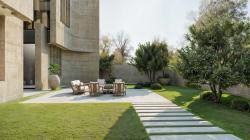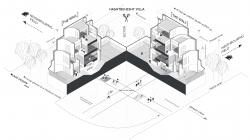Since the land division reforms in Iran and the dismantling of the serf lord system, the significance of surrounding walls has gained prominence in urban projects. The connection between villas, particularly their shared walls, has become a focal point of design considerations.
In many contemporary developments, buildings are often positioned towards the rear of their plots, resulting in the creation of narrow, seldom-used corridors. These corridors are intended to safeguard the privacy of adjacent structures; however, they frequently prove to be impractical and problematic.
This project takes a different approach by leveraging the potential of interior spaces to positively influence the surrounding environment. Unlike conventional designs that isolate buildings from their perimeter walls and leave windows facing neighboring properties—often leading to privacy concerns and visibility issues—this project seeks to harmonize the openings around the building.
By integrating the side wall with the land's perimeter, it effectively respects the privacy of neighboring villas while enhancing spatial organization. This structural innovation not only maintains a connection with the surroundings but also minimizes the visibility of the building itself. Consequently, it transforms previously underutilized open and semi-open spaces at the edges into valuable areas that enhance the overall functionality and appeal of the project. Ultimately, this approach fosters a sense of community by encouraging interaction among residents while preserving individual privacy.
2024
The Hasht Behesht project aims to enhance spatial quality and provide a novel experience for its users. This project features a central swimming pool where you can enjoy the outdoors while being sheltered from the heavy rain and snow of Damavand. Recreational facilities are also designed in the adjacent indoor space.
The project's goal is to create suitable utilization through the proper separation of programs for users. The materials used in the facade have been selected to align with the region's climate, and their development in the interior walls has strengthened the architectural reading and harmony of the design.
Considering the curved forms of the structure, it has been designed conventionally with a concrete frame due to financial constraints, which adds challenges to its execution.
Architect: Ahmad Feyz-Mohammad Javad Abdolhosseini
Interior Design: Dorsa Sadeghi
Visualization: Nasrin Eslami - Erfan Aghighi
Re-walled by ODD DESIGN in Iran won the WA Award Cycle 49. Please find below the WA Award poster for this project.

Downloaded 0 times.
Favorited 4 times












